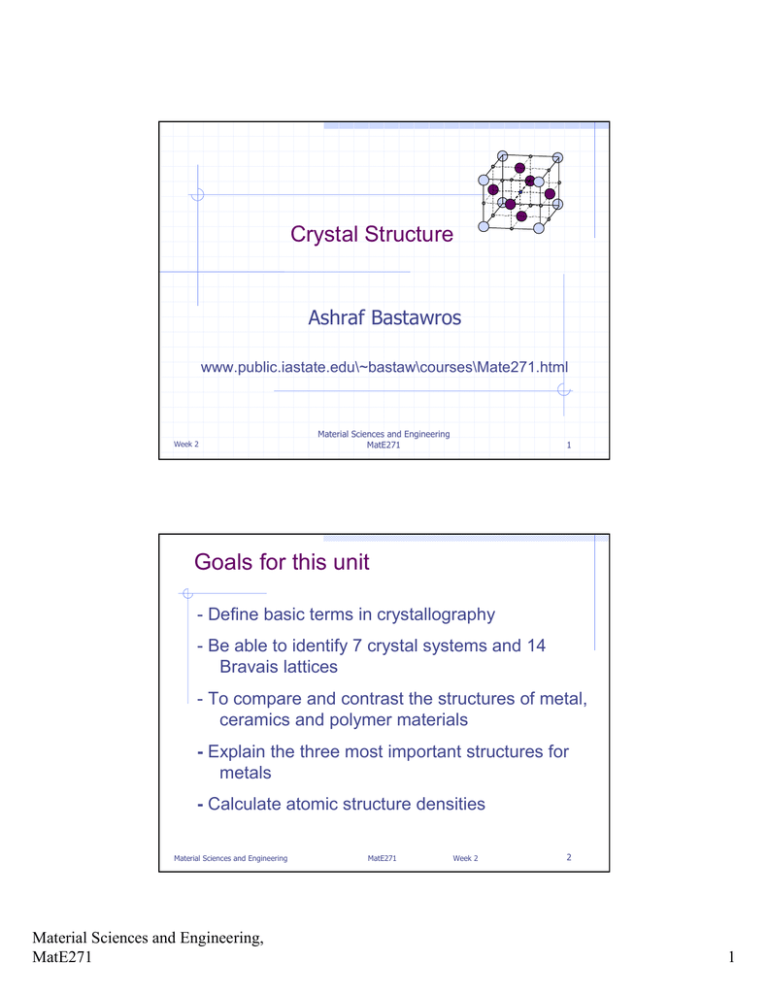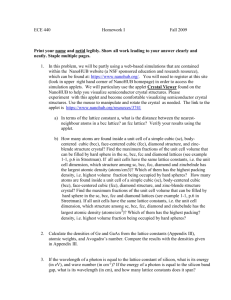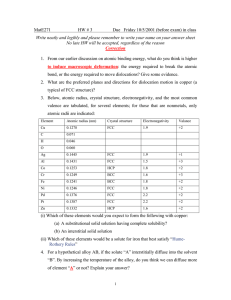Goals for this unit Crystal Structure Ashraf Bastawros
advertisement

Crystal Structure Ashraf Bastawros www.public.iastate.edu\~bastaw\courses\Mate271.html Week 2 Material Sciences and Engineering MatE271 1 Goals for this unit - Define basic terms in crystallography - Be able to identify 7 crystal systems and 14 Bravais lattices - To compare and contrast the structures of metal, ceramics and polymer materials - Explain the three most important structures for metals - Calculate atomic structure densities Material Sciences and Engineering Material Sciences and Engineering, MatE271 MatE271 Week 2 2 1 Crystal Structure and Periodicity • Crystalline Materials atoms are in an ordered 3-D periodic array Single crystal or polycrystalline solids (metals, ceramics, semiconductors, some polymers ) • Amorphous Materials short range order ( glasses, many polymers) • Intermediates Material Sciences and Engineering MatE271 Week 2 3 Crystal Structure and Periodicity Lattice - a 3-D array of positions in space. A geometric framework on which to hang atoms 2-D Unit Cell - the smallest repeat unit which defines the crystal structure 2-D 3-D Note - In these cases, there is one atom centered on each lattice site Material Sciences and Engineering Material Sciences and Engineering, MatE271 MatE271 Week 2 4 2 Simple Cubic (SC) SC lattice and crystal structure Lattice a = 2R Where: Hang 1 atom on each lattice point R = atomic radius atom a = lattice parameter Crystal Structure Material Sciences and Engineering MatE271 5 Week 2 Axes Labels By convention origin - 0,0,0 z c α β a b y γ x Lattice constant - a, b and c are lengths of edges - α, β, γ are angles (α is across from a, etc.) Material Sciences and Engineering Material Sciences and Engineering, MatE271 MatE271 Week 2 6 3 Crystal Systems (7-systems) Cubic a=b=c α=β=γ=90 Material Sciences and Engineering Tetragonal a=b≠c α=β=γ=90 Orthorhombic a≠b≠c α=β=γ=90 MatE271 Week 2 7 Crystal Systems (7-systems) Rhombohedral a=b=c α=β=γ ≠ 90 Hexagonal a=b≠c α=β=90 γ=120 “Pushed over” cube Material Sciences and Engineering Material Sciences and Engineering, MatE271 “Squished” tetragonal MatE271 Week 2 8 4 Crystal Systems (7-systems) Monoclinic a≠b≠c α=β=90, β ≠ 90 “Pushed over” orthorhombic (in one direction) Triclinic a≠b≠c α ≠ β ≠ γ ≠ 90 Orthorhombic a≠b≠c α=β=γ=90 Material Sciences and Engineering “Pushed over” orthorhombic (in two directions) MatE271 Week 2 9 Fourteen Crystal (Bravais) Lattices - Lattices are merely geometric constructs forming a framework of points in space on (or around) which you can position atoms - In the simplest case, you can apply one atom centered at each lattice point…Most METALLIC materials fall into this class - Represent the entire lattice with one unit cell Material Sciences and Engineering Material Sciences and Engineering, MatE271 MatE271 Week 2 10 5 Cubic Systems - Based on a Cubic unit Cell a=b=c, α=β=γ=90° n Simple Cubic (SC) w One atom on each corner w Coordination number of 6 n Body-centered Cubic (BCC) w One atom on each corner and one in the center w Coordination number of 8 n Face-centered Cubic (FCC) w One atom on each corner and on each face w Coordination number of 12 Material Sciences and Engineering MatE271 Week 2 11 Simple Cubic (SC) - SC lattice and crystal structure Lattice a = 2R Where: Hang 1 atom on each lattice point R = atomic radius atom a = lattice parameter Crystal Structure Material Sciences and Engineering Material Sciences and Engineering, MatE271 MatE271 Week 2 12 6 Body Centered Cubic (BCC) - BCC lattice and crystal structure A a = 4R 3 where: R = atomic radius atom a = lattice parameter B Staking order A-B-A-B Material Sciences and Engineering MatE271 Week 2 13 Week 2 14 Cubic Packing - BCC a √3a a √2 a √2 a a √3a=4R a=4R/√3 Material Sciences and Engineering Material Sciences and Engineering, MatE271 MatE271 7 Face Centered Cubic (FCC) a = 4R 2 a = 2R 2 where: R = atomic radius atom a = lattice parameter Stacking Direction [100] B A Staking order A-B-A-B Material Sciences and Engineering MatE271 Week 2 15 Cubic Packing - FCC a √2 a a 4R=√2a a=2R√2 Material Sciences and Engineering Material Sciences and Engineering, MatE271 MatE271 Week 2 16 8 Atomic Packing Factor - Fraction of solid sphere volume in a unit cell APF = volume of atoms in unit cell total cell volume - Example for FCC How many atoms are in the unit cell? What is the cell volume? Material Sciences and Engineering MatE271 Week 2 17 Atomic Packing Factor - FCC 4R Material Sciences and Engineering Material Sciences and Engineering, MatE271 - There are 4 spheres in the cell - The volume of the spheres: 4 3 16 3 4 × πR = πR 3 3 MatE271 Week 2 18 9 Atomic Packing Factor - FCC - What is the volume of the cube? n a3 (length of side cubed) - What is that in terms of R? (sphere radius) n n Material Sciences and Engineering a = 2R√2 (2R√2)3 = 16R3√2 MatE271 Week 2 19 Atomic Packing Factor - FCC APF = volume of atoms in unit cell = Vs /Vc total cell volume 16 πR 3 3 16 R 3 2 = π 3 2 = 0.74 The atomic packing factor for FCC is 0.74 (74% of the space is filled) Material Sciences and Engineering Material Sciences and Engineering, MatE271 MatE271 Week 2 20 10 HCP Crystal Structure This is not a lattice point! c a 0,0,0 HCP crystal structure = Hexagonal Bravais lattice with 2 atoms per lattice site. 1st atom at 0,0,0 (i.e. lattice point) 2nd atom at 2/3, 1/3, 1/2 Note - 2nd atom environment different than the 1st atom For “ideal” HCP only c = 1.633 a Material Sciences and Engineering MatE271 Week 2 21 HCP Crystal Structure This sphere is not totally inside unit cell although the partial spheres all add up so that there are two spheres per unit cell! Material Sciences and Engineering Material Sciences and Engineering, MatE271 MatE271 Week 2 22 11 ABA vs ABC Packing Material Sciences and Engineering MatE271 Week 2 23 Week 2 24 FCC and HCP Compared Material Sciences and Engineering Material Sciences and Engineering, MatE271 MatE271 12 Structure of Selected Metals Metal Aluminum Chromium Cobalt Copper Gold Lead Crystal Structure FCC BCC HCP FCC FCC FCC Material Sciences and Engineering MatE271 Atomic Radius (nm) 0.1431 0.1249 0.1253 0.1278 0.1442 0.1750 Week 2 25 Example Problem o If you know the crystal structure, the atomic radius and the atomic weight, you can calculate the density of a particular material. o Copper has an atomic radius 0.128 nm an FCC crystal structure and an atomic weight of 63.5 g/mol. Calculate its density. Material Sciences and Engineering Material Sciences and Engineering, MatE271 MatE271 Week 2 26 13 Crystalline & Noncrystalline Materials o Single crystals • repeated arrangement of atoms extends throughout the specimen • all unit cells have the same orientation • exist in nature • can also be grown (Si) • without external constraints, will have flat, regular faces Material Sciences and Engineering MatE271 Week 2 27 Polycrystalline Materials o Crystals of different • sizes • orientations • shapes o Grain Boundaries • mismatch between two neighboring crystals Material Sciences and Engineering Material Sciences and Engineering, MatE271 MatE271 Week 2 28 14 Polycrystalline Materials o Most crystalline materials are composed of many small crystals called grains o Crystallographic directions of adjacent grains are usually random o There is usually atomic mismatch where two grains meet - this is called a grain boundary o Most powdered materials have a many randomly oriented grains Material Sciences and Engineering MatE271 Week 2 29 Reading Assignment Shackelford 2001(5th Ed) – Read Chapter 3, pp 59-64 Read ahead to page 88, 101-110 Check class web site: www.public.iastate.edu\~bastaw\courses\Mate271.html Material Sciences and Engineering Material Sciences and Engineering, MatE271 MatE271 Week 2 2 30 15




